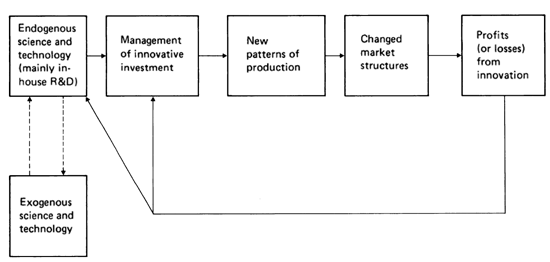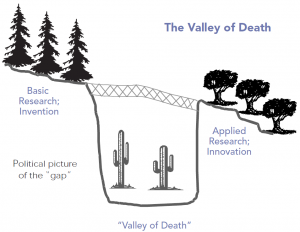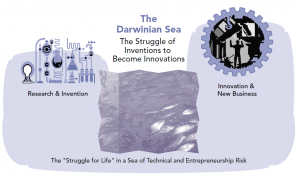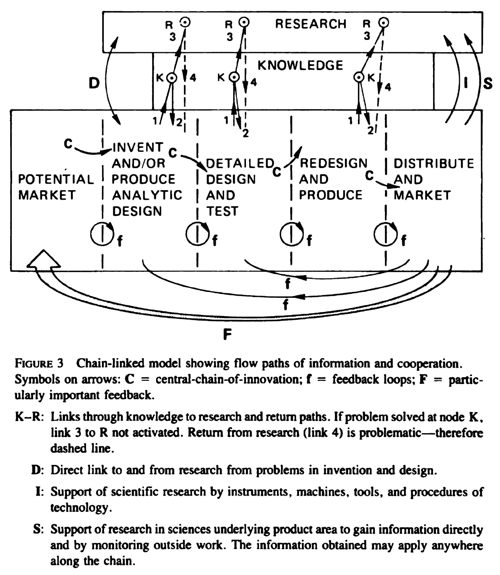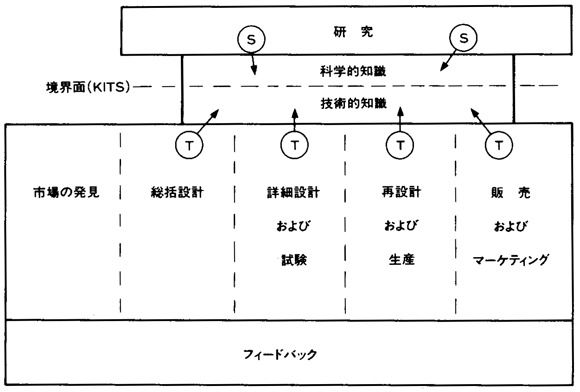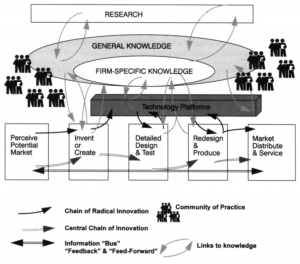「イノベーション現象を支配している基本的法則あるいは基本的メカニズムは何か?」「何を基本的要素としてイノベーション現象の歴史的展開プロセスを分析すべきか?」、「イノベーション・プロセスの構成要素間の関係はどのようなものなのか?」「イノベーション・プロセスの歴史的展開を基本的に規定している要素あるいはメカニズムは何か?」といった問題関心に基づいて、多様なイノベーション・モデルが提唱されている。
イノベーション・モデルの古典的見解とされているのが、「リニア・モデル」(linear model)である。それに対する批判として有名なのが「連鎖モデル」(Chain-linked Model)である。ここでは「リニア・モデル」と「連鎖モデル」に関わる基本的文献を紹介する。
なお「リニア・モデル」批判派は、「リニア・モデル」論者は一方向的な因果連鎖を主張している、として批判している。しかしながらそうした素朴なリニア・モデル論は単なる批判のためのわら人形に過ぎない。イノベーション・プロセスの構成要素の間での相互的連関の存在を認めないのはあまりに非現実的である。
Schumpeter Mark IIというリニア・モデル論的イノベーション・モデルで明示的に示されているように、下記で挙げる諸リニア・モデルも「最も基本的な」因果的連関に関わる議論であり、具体的な歴史的=社会的現象としてフィードバックや逆作用が存在することまで否定するものではない、と考えるべきである。
Klein=Rosenberg的用語法で言えば、「イノベーションの中心的連鎖」(cental-chain-of-innovation)は何かという視点から論争を再構成すべきなのである。
また社会的視点からは、「イノベーション・モデルの基本的「要素」ではなく基本的「要素活動」として議論する」こと、「構成要素間の「因果」的連関ではなく、構成要素活動間の「相互」的連関関係として議論する」ことが正当である。
例えば、技術的知識や特許などという基本的「要素」ではなく、技術的知識や特許を生産する活動、道具・機械・センサー・コンピューターを設計・生産する活動としての技術的活動という基本的「要素活動」を基本的対象として、イノベーション・プロセスを分析すべきである。(もちろん哲学的視点からは基本的「要素活動」視点からの分析とともに、基本的「要素」視点からの分析も重要ではある。)
1. イノベーションを構成する諸要素とそれらの間の基本的因果的連関に関する「リニア・モデル」
基本的モデル
Basic research -> Applied research -> Development -> (Production and) Diffusion
派生的モデル(1)
Science -> Technology -> Business -> Market
派生的モデル(2)
研究 -> 開発 -> 生産 -> 販売
2.リニア・モデルの歴史的展開を論じた文献
Godin, B. (2006) “The Linear Model of Innovation: The Historical Construction of an Analytical Framework,”
Science, Technology, & Human Values, Vol. 31, No. 6 (Nov., 2006), pp.639-667
http://www.jstor.org/stable/29733964
B. Godinは、「リニアモデルはBushにほとんど何も負ってはいない。リニアモデルは、実業家(industrialists), コンサルタント、ビジネススクールによる理論的構成物(theoretical construction)である」(pp.640-641)とするとともに、リニアモデルの形成の歴史を下記の3段階に分けている。
第1段階(20世紀初頭から1945年頃まで) — 基礎研究と応用研究の間の因果的連関(a causal link)、実業家(industrialists)および United States National Research Councilが提唱者
第2段階(1934年から1960年頃まで) — 開発(development)という語句が付け加わり、Basic research -> Applied research -> Developmentというモデルが形成される
第3段階(1950年代以降) — ビジネススクール出身のエコノミストが生産(Production)および普及(Diffusion)という非R&D的活動を付け加えた
3.リニア・モデルを主張した最初の文献と一般にされているBushレポート — その先行的証言、および、Bushレポートのポイント
1) Bushレポートに先行するBushの議会証言
Temporary National Economic Committee (1939)
Investigation of Concentration of Economic Power : Hearings before the Temporary National Economic Committee, Congress of the United States. 76 Congress. First Session. Part 3 Patents, Proposals for Changes in Law and Procedure, January 16, 17, 18, 19, AND 20, 1939., U. S. Government Printing Office.pp.870-911.
Vannevar Bush, president, Carnegie Institution of Washingtonは、1939年1月17日にTemporary National Economic Committeeの特別顧問(special counsel) John A. Diennerの質問に答えて下記のような証言をおこなっている。
Introduction of New Ideas Into Industryという小見出しのもと、p.871でBushは新しい知識から、新しい応用(application)が生み出されるとしている。
Mr. Dienner. Under modern conditions in industry, how do new ideas come forward? I mean by that, consider the individual, consider the corporation, or other forms under which enterprise is conducted. How do these ideas come forward? What produces them?
Dr. Bush. There are two ways that are important. First, they result oftentimes from the long program of research, careful and meticulous analysis of the situation by a group of men, through large industrial research laboratories or scientific institutions, and the like, which produce new knowledge out of which come new applications. In addition, there is the independent inventor, whose day is not past by any means, and who has a much wider scope of ideas and who often does produce out of thin air a striking new device or combination which is useful and which might be lost were it not for his keenness.
Researchという小見出しのもと、p.872でBushはResearchを「体系的調査による新しい知識の発見」(the discovery of new knowledge by systematic examination)と定義するともに、「純粋基礎研究」(pure basic research), 「応用研究」(applied research), 「製品コントロールのための研究」 (research for control of a product)に3分類している。
Mr. Dienner. You speak of research. Will you please explain so that we may understand the term and its implications what is generally understood among those who practice research, what that subject and what their activities may be?
Dr. Bush. Research, of course, is broadly the discovery of new knowledge by systematic examination, and it can be classified on one basis, into pure basic research, applied research, and research for control of a product.
Mr. Dienner. Is there any fundamental difference in industry itself as to scientific search for principles, or the application of those principles in applied research?
Dr. Bush. There is considerable difference in the way in which it is controlled. In pure research, basic research, men are left comparatively free to follow out their own ideas. In applied research they are of necessity guided in the direction of interest of the company which employs them.
2) Bushレポート
下記でBushレポートをダウンロードすることができる。
3) Bushによる基礎研究および応用研究の理解
「基礎研究(basic research)は実際的目的(practical ends)を考慮に入れることなく遂行される。基礎研究は、一般的知識(general knowledge)、自然に関する理解、そして自然法則を生み出す。こうした一般的知識は、数多くの重要な実際的問題(practical problem)に答えるための手段(means)を提供する。ただし一般的知識は、すべての実際的問題に対して完全に明確な答えを与えるとは限らない。実際的問題に対してそうした完全な答えをあたえることが、応用研究(applied research)の機能である。基礎研究をおこなう科学者は、自らの研究の実際的応用(practical applications)にまったく関心を持たないかもしれない。しかし基礎的科学研究が長く無視されるならば、産業発展(industrial development)がやがては止むことになるであろう。」p.18
「基礎研究は新しい知識をもたらす。基礎研究は科学的資本(scientific capital)を提供する。基礎研究は、知識の実際的応用がそこから導き出されるファンドを創り出す。」p.19
4.Bush関連文献
December 9, 1994, June 9, 1995, and September 21-22, 1996に開催されたシンポジウムの記録
Part I.
1) Understanding the Bush Legacy – Jonathan Cole
2) Understanding the Bush Report – Harvey Brooks
3) Completing the Bush Model: Pasteur’s Quadrant – Donald Stokes
4) Chalk or Cheese?: Ends and Means in Science Policy – David Hart
5) Show Me the Money: Budgeting in a Complex R&D System – David Robinson
6) Two Cheers for Democracy: Science and Technology Politics – Bill Green
Part II.
7) Universities: Costs and Benefits on the Academic Frontier – Donald Kennedy
8) Federal Laboratories: Understanding the 10,000 – Barry Bozeman
9) Technological Change: Connecting Innovation to Performance – Nathan Rosenberg
10) Health: The Devil of a Problem – Nathan Rosenberg
11) Health Care: Coping with Consolidation – Kenneth Shine
12) International Cooperation: What’s in it for Us? – Eugene Skolnikoff
13) Social Sciences: Shunned at the Frontier – Susan Cozzens
Part III.
14) Toward a National R&D Policy – Peter Eisenberger
15) Beyond the Endless Frontier – Michael Crow
5.リニア・モデル論的イノベーションモデル
(1) Schumpeter Mark IおよびSchumpeter Mark II
a. Schumpeter Mark I的イノベーション・モデル
b. Schumpeter Mark II的イノベーション・モデル
[図の出典]Freeman, C., Soete, L.(1982) Unemployment and Technological Innovation: a study of Long Waves and Economic Development, Frances Pinter, pp.39-40
後年になってからの定式化ではあるが、シュンペーターはイノベーション・プロセスに関してSchumpeter Mark IおよびSchumpeter Mark IIという2種類のモデルを提唱した、と一般にされている。
両モデルの違いは、イノベーションの遂行主体の性格の違いに由来するものである。図5のシュンペーターMarkIは「企業家」主導的イノベーションを、図6のシュンペーターMarkIIは「大企業」主導的イノベーションを表すものである。「企業の外部にある外生的な科学活動や技術的発明活動を想定するか否か」に違いはあるにしても、MarkIとMarkIIというどちらのイノベーション・モデルも科学や発明を端緒としており、シーズ主導説的モデルである。
シュンペーターMarkIは、Schumpeter(1912) で展開された議論に基づくものであり、現代的な用語で言えばスタートアップ企業によるイノベーションをモデルとしており、イノベーションの遂行主体として「諸制約から自由な主体」を想定している。すなわち、「独創的発見や独創的発明こそがイノベーションをもたらす。そして独創的発見や独創的発明の源泉は、なにものにも縛られない自由な創造的活動であるが、大企業に見られるような硬直的で官僚的な制約の下ではそうした自由な創造的活動は困難である。独創的な創造活動の担い手としては、大規模組織よりは小規模組織が、組織よりは個人の方が適している。」という発想に基づくものである。
これに対して、シュンペーターMarkIIは、Schumpeter(1942) で展開された議論に基づくものであり、製薬産業などイノベーション遂行に必要な大規模な研究開発投資に対応できる大企業によるイノベーションをモデルとしており、イノベーションの遂行主体として「実現の自由を持つ主体」を想定している。すなわち、「大きな産業的変革をもたらすイノベーションを引き起こためには長期にわたる巨額な研究開発投資を必要とすることが多い。しかも環境に優しい自動車に関するイノベーションにおいてハイブリッド自動車、電気自動車、燃料電池車など多種多様な製品設計が存在することに示されているように、どの技術イノベーションが成功するのかは予測困難であり、イノベーションにはリスクがつきものである。また産業の高度化、および、製品の複雑化にともないイノベーション遂行には、様々な領域にまたがる多種多様な既存技術の利用や新規技術の開発が必要とされるようになっている。しかしそうしたことは個人や新興ベンチャー企業には困難である。」といった発想に基づくものである。
[図の出典]
6.最近のリニア・モデル擁護論、および、リニア・モデル論的視点からの事例研究
- Balconi, M., S. Brusoni, and L. Oresnigo. (2010) “In Defence of the Linear Model: An Essay.” Research Policy 39 (1): 1-13.
- Khilji,Shaista E. and Tomasz Mroczkowski, and Boaz Bernstein(2006) “From Invention to Innovation: Toward Developing an Integrated Innovation Model for Biotech Firms�” The Journal of Product Innovation Management,23, pp.528-540
バイオテクノロジーを例に取り、InventionからInnovationへの移行(transformation)が論じられている。著者は、inventionに関して「invention (i.e., breakthrough scientific discovery)」とするとともに、innovationに関して「innovation (i.e., a socially usable and marketable product)」としている。
7.リニア・モデルを批判した文献[年代順]
- Price, William J. and Lawrence W. Bass (1969) “Scientific Research and the Innovative Process,” Science 16 May 1969, pp.802-806.
本論文ではイノベーションが知識の発見から始まるとする見解を「リニア」モデル(”linear” model)と呼んでいる。[p.803]そうした上で、「科学と技術の間での対話はイノベーションにおいて重要な役割を果たしてはいるが、通常はリニア的ではない。」(The dialogue between science and technology plays an important, but usually nonlinear, role in innovation.)[p.802]と主張している。
なお著者たちは、「科学的研究は、イノベーション・プロセスの本質的部分である。」(It is certainly true that basic scientific research is an essential part of the innovative process.)[p.806]と考えながらも、リニアモデルに反対している。
- Kline, S. J. (1985) “Innovation is Not a Linear Process.” Research Management 28(July-August): 36-45.
- Kline, Stephen J. and Nathan Rosenberg (1986) “An Overview of Innovation.” In The Positive Sum Strategy, edited by Ralph Landau and Nathan Rosenberg, Washington, D.C.: National Academy Press, pp.275-304
- Rosenberg, N. (1994) Exploring the black box: Technology, economics, and history. New York:Cambridge University Press.
- 沼上幹(1999) 「行為の運鎖としての技術革新スペクトラム」『液晶ディスプレイの技術革新史 ― 行為連鎖システムとしての技術』白桃書房、pp.523-559
- Edgerton, D. (2004) “‘The linear model’ did not exist: Reflections on the history and historiography of science and research in industry in the twentieth century” in The Science-industry Nexus: History, Policy, Implications, edited by K. Grandin, N. Worms, and S. Widmalm, 31-57. Sagamore Beach, MA: Science History.
- Grandin,K., Wormbs, N., Widmalm, S. (eds,2005). The Science–Industry Nexus: History, Policy, Implications. (Nobel Symposium, 123.) Science History Publications.
- 上記の本に対する書評:Nye, D. (2006) “From Science to Industry? : Flaws in the Linear Model,” ISIS, 97, pp.543-545
8.リニア・モデル批判としてのKlein=Rosenbergによる連鎖モデル(Chain-linked Model)
(1) Klein=Rosenbergによる連鎖モデル
同一の図が、Meyers, M.B., Rosenbloom, R.S. (1996) “Rethinking the Role of Industrial Research,” in Rosenbloom, R.S., Spencer, W.J.(eds), Engines of Innovation: U.S. Industrial Research at the End of an Era, Harbard Business School Press, p.213、および、クライン,S.J.(1990,鴫原文七訳1992)『イノベーション・スタイル』アグネ承風社,p.20に収録されている。
リニア・モデルに対する代替案として有名なのが、Klein=Rosenbergの連鎖モデル(Chain-linked Model)である。
連鎖モデルでは、図に示したように「潜在的市場」がイノベーション・プロセスの端緒とされ、それに続いて「発明、分析的設計」、「詳細設計および試験」、「再設計および生産」、「流通および市場」という順で「イノベーションの中心的連鎖」(central-chain-of-innovation、図のCの矢印)が構成されている。
「潜在的市場」がイノベーション・プロセスの端緒とされている点において、また「潜在的市場」→「発明、分析的設計」→「詳細設計および試験」→「再設計および生産」→「流通および市場」という「イノベーションの中心的連鎖」(cental-chain-of-innovation)が想定されている点で、「Klein=Rosenbergの連鎖モデルは、ニーズ主導説的立場に立つイノベーション・モデルとして位置づけられる。
ただし相互作用の実際的内容および「潜在的市場」概念が曖昧であるため、それらが実際に何を意味しているのかに関する理論的解釈の仕方によっては、連鎖モデルの理論的位置づけが変化する。すなわち連鎖モデルは、用語の上では「市場」というニーズ的要素を端緒としているが、「潜在的市場」が単に「社会的必要性や社会的有用性に対する技術的充足の実現可能性」を意味するものに過ぎなければ、シーズ=ニーズ主導説的見解として解釈することも論理的には可能である。
また「研究」プロセスは、リニア・モデルとは異なり、イノベーション・プロセスの外に位置づけられ、知識を通じてイノベーション・プロセスと繋がる外部的存在とされている。
「研究」と「発明、分析的設計」という両要素に直接的リンク(図の双方向的矢印D)の存在が想定されてはいるが、これは相互作用の存在を示すものであって時系列的な因果性の存在を示すものではない。
(2) Kleinによる改良連鎖モデル
[図の出典]クライン,S.J.(1990,鴫原文七訳1992)『イノベーション・スタイル』アグネ承風社,p.20
Kline, Stephen Jay (1990) Innovation Styles in Japan and the United States; cultural bases; implications for competitiveness, Stanford University, Department of Mechanical Engineering, Thermosciences Division
9.Meyers=Rosenbloomによる修正連鎖モデルとしてのTotal Process Model
[図の出典]Meyers, M.B., Rosenbloom, R.S. (1996) “Rethinking the Role of Industrial Research,” in Rosenbloom, R.S., Spencer, W.J.(eds), Engines of Innovation: U.S. Industrial Research at the End of an Era, Harbard Business School Press, pp.216[邦訳、マイヤーズ、M.B., ローゼンブルーム、R.S. (西村吉雄訳、1998)「企業における研究の役割の再検討」ローゼンブルーム,R.S., スペンサー, W.J.編『中央研究所時代の終焉:研究開発の未来』日経BP社、第9章、p.288]
M.B.MeyersとR.S.Rosenbloomは、「技術プラットフォーム」、「一般的知識」、「企業固有の知識」といった要素を取り入れて修正した連鎖モデルを提唱している。
10.リニア・モデルはその批判派の中にしか存在しないとする見解(2019.01.26追記)
Edgerton D (2004) “The linear model’ did not exist” In: Grandin K, Wormbs N and Widmalm S (eds) The Science-Industry Nexus : History, Policy, Implications. Bourne, MA: Science History Publications, 3 1-57.


